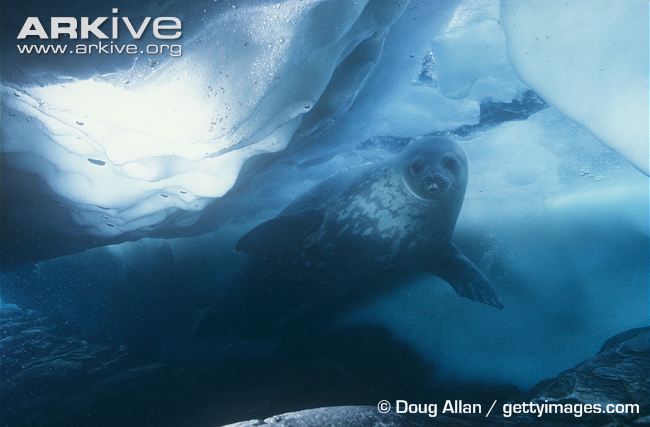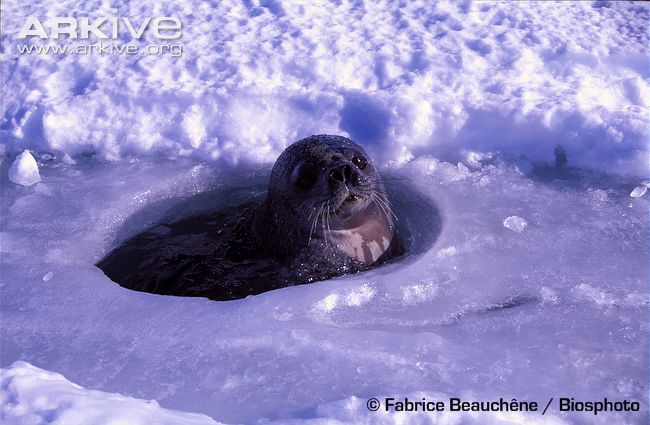Habitat
Weddell seals inhabit the
coastal waters around Antarctica (Gardner and Heider
1969). These seals live on ice near open water. The sea is their only food source in this climate. This causes Weddell seals to populate near areas with an
opening in the ice. Weddell seals have also been
found inhabiting coastal areas near islands around
Antarctica and off the coast of the southern tip of
South America (Gardner and Heider 1969). However,
the majority of Weddell seals dwell in the arctic
coastal areas around Antarctica.
Heider
1969). These seals live on ice near open water. The sea is their only food source in this climate. This causes Weddell seals to populate near areas with an
opening in the ice. Weddell seals have also been
found inhabiting coastal areas near islands around
Antarctica and off the coast of the southern tip of
South America (Gardner and Heider 1969). However,
the majority of Weddell seals dwell in the arctic
coastal areas around Antarctica.

The arctic climate that Weddell seals live in is
extremely harsh and unforgiving. Air
temperatures reach as low as -70 degrees Fahrenheit, and
the water temperature is just below freezing (Gardner
and Heider 1969). Weddell seals are able to endure
the subzero temperatures and blistering winds due to the
ability to produce large amounts of fat cells for
insolation (Gardner and Heider 1969, Heerah et al.
2013). This aspect also allows the Weddell seal to be the most
southern breeding seal able to inhabit this climate year
round (Gardner and Heider 1969, Heerah et al. 2013). Their body morphology allows them to withstand swimming
in the freezing Antarctic water.
Weddell seals must live near open areas within the ice
because they rely on the ocean for travel and as a food
source. Although they spend time surfaced on the
ice, Weddell seals devote multiple hours a day diving
under the ice for food, travel, and adventure. The
average Weddell seal travels around 370.4 km per day
(Heerah et al. 2013). The main reason why these animals
travel great distances is to find prey. When
Weddell seals dive looking for food, they usually dive
to a specific spot where there is a large abundance of
food. These areas hover over a breathing hole that
has been dug out within the ice (Heerah et al. 2013). Breathing
 holes are created by a Weddell seal using its
teeth to dig out a hole in the ice (Gardner and Heider
1969). Here is a video of a Weddell seal carving
out a breathing hole in the ice (Weddell
seal a breathing hole). This allows Weddell seals to surface to a breathing hole
to take in more air and continue searching for prey. However, prey resources in popular feeding grounds
deplete forcing Weddell seals to explore to find new
feeding grounds (Heerah et al. 2013). This causes them to
travel great distances and explore multiple oceanic
levels daily.
holes are created by a Weddell seal using its
teeth to dig out a hole in the ice (Gardner and Heider
1969). Here is a video of a Weddell seal carving
out a breathing hole in the ice (Weddell
seal a breathing hole). This allows Weddell seals to surface to a breathing hole
to take in more air and continue searching for prey. However, prey resources in popular feeding grounds
deplete forcing Weddell seals to explore to find new
feeding grounds (Heerah et al. 2013). This causes them to
travel great distances and explore multiple oceanic
levels daily.
List of references use in this section:
ARKive 2013.
Gardner, R. and K. G. Heider. 1969. The Weddell Seal. Scientific American Inc.
Heerah, K., V. Andrew-Goff, G. Williams, E. Sultan, M. Hindell, T. Patterson and J. Charrasin. 2013. Ecology of Weddell seals during winter: Influence of environmental parameters on their foraging behavior. Deep-Sea Reseach II 88-89:23-33.
Choose your adventure:
To learn how this seal is adapted to Antarctica's hash environment, click here.
OR
To return back to the home page, click here.